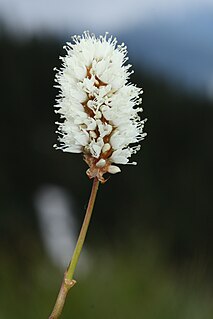This page is based on this
Wikipedia article Text is available under the
CC BY-SA 4.0 license; additional terms may apply.
Images, videos and audio are available under their respective licenses.

Polygonum is a genus of about 130 species of flowering plant in the buckwheat and knotweed family Polygonaceae. Common names include knotweed, knotgrass, bistort, tearthumb, mile-a-minute, smartweed and several others. In the Middle English glossary of herbs Alphita, it was known as ars-smerte. There have been various opinions about how broadly the genus should be defined. For example, buckwheat has sometimes been included in the genus as Polygonum fagopyrum. Former genera such as Polygonella have been subsumed into Polygonum; other genera have been split off.

Bistorta vivipara is a perennial herbaceous flowering plant in the knotweed and buckwheat family Polygonaceae, commonly known as alpine bistort. Scientific synonyms include Bistorta vivipara and Polygonum viviparum. It is common all over the high Arctic through Europe, North America, and temperate and tropical Asia. Its range stretches further south in high mountainous areas such as the Alps, Carpathians, Pyrenees, Caucasus, and the Tibetan Plateau.
Dragonwort is a common name for a plant which may refer to:

A bog garden employs permanently moist soil to create a habitat for plants and creatures which thrive in such conditions. It may exploit existing poor drainage in the garden, or it may be artificially created using pond liners or other materials to trap water in the area. Any such structure must allow a small amount of seepage to prevent the water stagnating. For instance, a pond liner must be pierced a few times. Typically a bog garden consists of a shallow area adjoining a pond or other water feature, but care must be taken to prevent water draining from a higher to a lower level. The minimum sustainable depth is 40–45 cm (16–18 in). Good drainage is provided by gravel placed over the liner, and the bog can be kept watered by using a perforated hose below the surface.

Bistorta affinis, the Himalayan bistort, fleece flower, or knotweed, is a species of flowering plant in the family Polygonaceae, native to the Himalayas.

Camissoniopsis bistorta is a species of flowering plant in the evening primrose family known by the common names southern suncup and California suncup. It is native to southern California and Baja California, where it grows in several types of plant community along the coast and in the coastal hills and mountain ranges. This is a hairy annual or perennial herb spreading from a basal rosette with stems reaching up to 80 centimeters long. Leaves are lance-shaped to narrowly arrowhead-shaped and sometimes toothed, and 1 to 12 centimeters in length. Toward the end of the spreading stems are nodding inflorescences of flowers, each flower with four bright yellow petals dotted with red at their bases. At the center are stamens and a protruding, nearly spherical stigma. The fruit is a straight or slightly coiled capsule up to 4 centimeters long.

The Shining marbled (Pseudeustrotia candidula) is a moth of the family Noctuidae. The species can be found from Europe to Japan.
Ridings' forester or the mountain forester is a moth of the family Noctuidae. It is found as far east as the eastern edge of the Rocky Mountains in Colorado. It is also found in Arizona, Utah, all of California and northward into Oregon, Idaho, Washington, British Columbia and Alaska

Middle Side and Stonygill Meadows is a Site of Special Scientific Interest in the Teesdale district of County Durham, England. It consists of two separate areas, one to the north of the River Tees, the other on the south bank, about 2 km upstream from the village of Middleton-in-Teesdale. The Park End Wood and Middle Crossthwaite SSSIs lie on the same stretch of floodplain, the Teesdale Allotments SSSI is a short distance to the north, while the higher ground to the south of the river is part of the Upper Teesdale SSSI.
Coleophora pratella is a moth of the family Coleophoridae. It is found from France and Belgium to Latvia, Lithuania, Poland, Romania and Bulgaria and from Germany to Italy, Austria and Hungary.

Bistorta amplexicaulis, the red bistort or mountain fleece, is a species of flowering plant in the buckwheat family, native to China, the Himalayas, and Pakistan. It is a damp-loving herbaceous perennial growing to 1.2 m (4 ft) tall and wide, with heart-shaped pointed leaves, downy beneath, and narrow spikes of rose-red or white flowers in summer.

Bistorta macrophylla is a flowering plant species in the buckwheat family Polygonaceae. It is native to mountain regions of West and South China, Bhutan, Nepal, North and West India, and Pakistan.
B. macrophylla may refer to:
P. macrophyllum may refer to:

Bistorta manshuriensis, Asian bistort, is an unresolved name for a proposed flowering plant species in the buckwheat family Polygonaceae. It is a perennial herbaceous plant found in mountain valleys and lowlands in Korea and Japan. It grows well in sunny or slightly shaded places. It grows up to 30 centimetres (12 in) - 80 centimetres (31 in).

Bistorta abukumensis is a species of flowering plant in the family Polygonaceae, native to Japan. It was first described in 1995.

Bistorta griffithii is a species of flowering plant in the family Polygonaceae, native to Tibet, East Himalaya, South-Central China and Myanmar.














